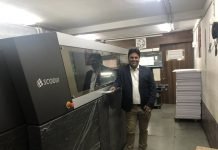HP launched a new range of dye sublimation textile printers in India for the first time at Gartex 2019 in New Delhi. From the inkjet printers in the new Stitch S series, the S500 was displayed, and while the Stitch S1000 was being talked about and available for sale, it was not put on display.
Vitesh Sharma, country manager, HP India said, “Dye-sublimation printers first print on paper, following which the print is transferred to fabric. The machines we are launching have some new twists and improvisations. The S500 is a 5-foot wide machine while the S1000 is 10-feet wide.”
Explaining the improvements in the newly launched printers, Sharma said, “A big concern for customers is the color consistency. Because of the inherent design of dye-sublimation printers, it is difficult to match the color consistency of print across different batches produced in the same machine at different locations. With time, the machine deteriorates and so does the color consistency. The new Stitch S series has an inbuilt spectrophotometer and Cloud-based profiling for color standardization. You can create one profile for a design and it will be printed with the same color consistency on all the machines no matter where they are installed provided the same profile is used. Brands like Zara have multiple manufacturing locations; by using the Stitch S series, their garments printed at different locations will have the same look and feel.”
According to Sharma, Indian textile export is expected to grow to US$ 82 billion by 2021. The overall textile market of India is US$ 150 billion a year. The textile segment contributes 7% to the country’s total output and is 2% of the Indian GDP.
Personalization for GenZ
“However, the penetration of digital textile printing is very small. Garments are still being printed conventionally. But for times to come, digital textile printing will increase. Apart from sustainability benefits, digital textile printing has other advantages including the ability to provide personalized prints. GenZ prefers uniqueness and personalization and that is not possible on traditional printing machines.

















